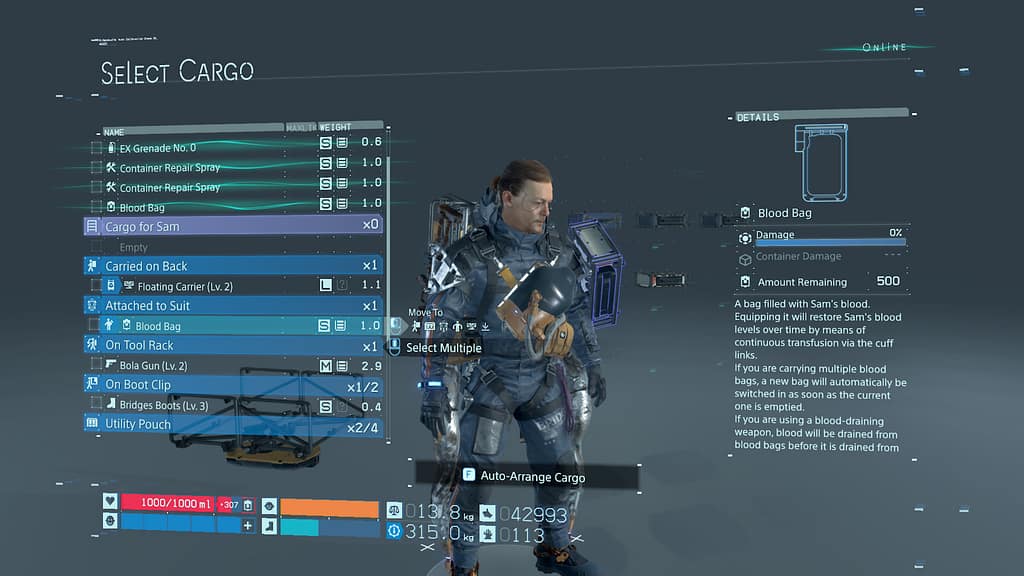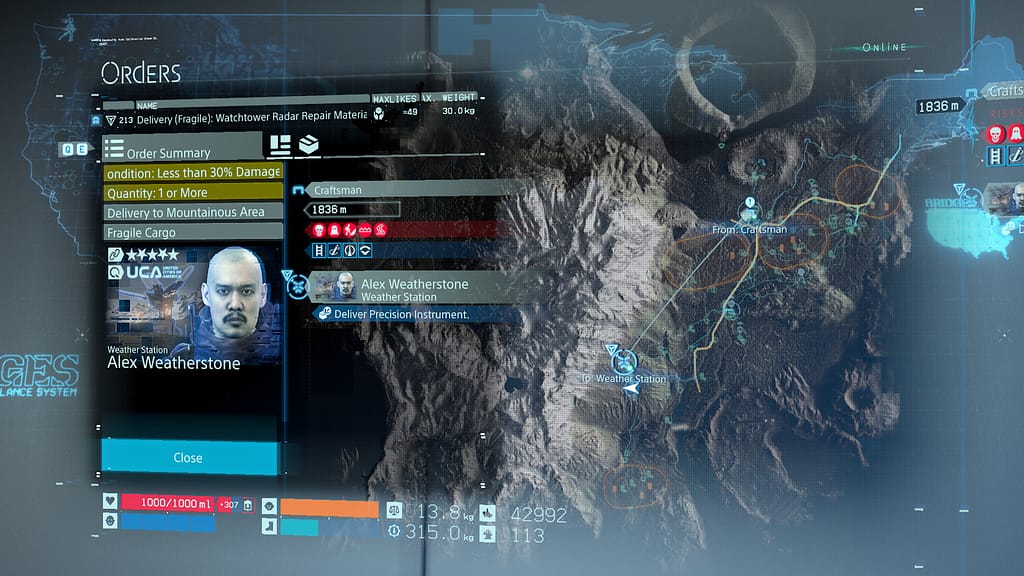Okay, let me name the elephant in the room right at the beginning: Death Stranding may be a very good game. Or a very bad one. Or maybe it’s not a game at all. I still can’t agree with myself after twenty hours of play. Perhaps that’s because much of the open-world game takes place in the microcosm of menus and interfaces.
Death Stranding’s user interfaces crack me up. They are a sensory overload in a rocket-free New Year’s Eve sky. A kaleidoscope of selection paralysis. I could spend hours with them and not recap at the end whether they were enjoyable or torture.
Briefly for classification: user interfaces are everything that is not a character, game object or game world. Menus, buttons, texts, status bars, selection lists, buttons again, heads-up displays, etc. Got it so far? Then onward.
Kojima’s passion for “digitally authentic” interface design became apparent early on. When Microsoft was torturing us with WordArt and far too many “graphic designers” were falling in love with Photoshop’s bevel-and-emboss feature, Hideo was already showing off his sober, low-color, iconic style in Metal Gear Solid in 1997. Clean lines, geometry, exemplary icons, not an ounce of fat on a selection box. Metal Gear Solid’s item and weapon selection was purist, almost futuristic for the time. Compared to other playful, decorative display elements, they almost seemed a bit unfinished. As if they were still placeholders from a developer-only release, as if I were communicating with a cold computer. And just that did the job enormously well, because they were clear, distinct and, despite all cryptics, readable.

Smart-ass people like me know that skeuomorphism (the art of designing elements based on real-world objects), as used by other designers, can be quite useful. A button that actually looks a bit like a button doesn’t need any explanation of how I can use it. A surface that looks like paper invites you to write or read on it. I can tell if something is interactive or not by the shape, the cast of shadows, or the color contrast. If my mana reservoir actually looks like a liquid in a glass container, it can blend in beautifully with the style of the world. Even today, many games take the liberty of designing the cursor and mouse pointer to mimic a wand, a hand, or anything “real” from the game world. Like an appropriately chosen font, this pays off in terms of readability and connection to the game.
I wonder if this was too mainstream for the weirder mind of Kojima. In any case, his style remains an unmistakable contrast to the common standard, which has only become a little closer to purism in the course of the digital revolution in recent years. The fact that the principle has nevertheless worked well for decades is due to a decisive design aspect: feedback.
Anyone who plays shooters can tell without explanation whether a weapon looks powerful and coarse or precise and delicate. Animation and sound combine to create a feeling where we think we can feel the recoil in our hands. It’s no different with interfaces. An input can feel heavy-handed and important, or quick and incidental. In Death Stranding, this design philosophy finds its most consistent application yet. The interface doesn’t just flash and pulse, it beeps and buzzes and gives feedback. It celebrates its existence for minutes at a time. At the end of a delivery mission, screen after screen appears, statistics fade in, numbers count up, bars and diagrams fill up. Sometimes automatically, sometimes at the push of a button. They twitch and wobble as if dancing to the joy of being alive. And our synapses dance along.
None of these elements resembles a real thing, a thing you could hold in your hand. They can only exist in the digital. No rounded corners, as we know them from smartphones, or sounds that remind us of noises from everyday life soften the simulation. It is authentic in its very own way and speaks a language that some have long understood, others have yet to learn.

It’s too much at times. So much more than this barren landscape through which I move Sam Porter Bridges, so I have to conclude that this is where the real game is hidden. Figuring out complex things is fun because you can discover something new with every encounter. I remember when I was a kid, I started to understand my parents’ stereo system. Not every button was equally important, some led immediately to a result (turn it down!), others only with some practice. And to this day, depending on the setup, it remains a guessing game as to what that “aux” setting might do.
I don’t think and hope that our everyday surfaces will all feel like this at some point. But maybe when digital natives eventually outnumber boomers and millennials and augmented reality contact lenses become standard, it will happen. Well, if that’s the way it has to be, I wish they were user interfaces in the spirit of Kojima (and came with controllers).
Death Stranding is a delivery boy simulator starring Norman Reedus, developed by his best bro game designer Hideo Kojima, who launched the game entirely without Konami in the summer of 2020 with Kojima Productions. The whole thing plays like MGS5, only without the exciting parts. Somehow it’s about the USA, afterlife babies and bridge building in the post-apocalypse. But really, the setting is just background noise for hours of menu navigation.
This post is also available in:
![]() German
German

